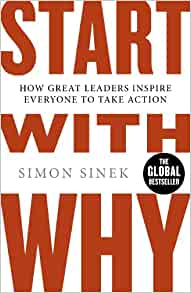
Start With Why
This book is a helpful reminder to start with WHY or begin from somewhere very different. When you begin with Why you get the chance to align What you do with How you do it. Your life, products, or services are designed by the decisions that uphold your Why. And that is inspiring.
By design or manipulation
There are two ways to influence behaviour
Inspire
Manipulate
Why, How and What (in that order) make up The Golden Circle. Great companies organise their resources around their Why to ensure What they do and How they do it clearly reflects their Why.
The alternative is to influence behaviour through manipulation. Recognisable manipulations in business include:
Price
Promotions
Fear
Aspirations
Peer pressure
Novelty
True innovation changes the course of an industry. Changing the colour of packaging does not.
Think bigger. Would a quarter of US railroad companies have gone bust in 1894 had they seen themselves as mass transportation companies?
Apple works to empower the individual by providing 1000 songs in your pocket. The competition tells you What they do and How they do it, giving you a 5GB MP3 player.
Using biological systems as an analogy
Why: Limbic
What and How: Prefrontal cortex
We can win the mind by overusing features and benefits, the heart is a little trickier.
We can’t explain Why we like Apple but we can verbalize or rationalise our decisions through What we do and How we do it. It is unlikely to be a true reflection of our Why but it is a rationalised answer.
The emergence of trust
Focus on the people who believe what you believe. The goal of business should not be to do business with anyone. When you are selective about who you do business with, trust emerges.
Communicate your why and then demonstrate it by acting on your values and beliefs. When we have a sense that another person or organisation is driven by things other than self-interest, trust emerges.
A company is a culture. A group of people brought together around a common set of values and beliefs. Hire for attitude, not skills. Recruit on the Why. Skills you can acquire.
Great companies don’t hire skilled people and motivate them they hire already motivated people and inspire them
In pursuit of why. Great companies hold themselves accountable for how they do it. What they do serves as tangible proof of what they believe in, their Why.
Dilution of the why [the thing that kills your coaching]. Come to work. Manage systems
Work on preset goals. No longer inspired by the cause greater than themselves. As the company grows the Why is diluted and at some point the What they do and Why they do it diverge.
What you measure gets managed. A desire to return to the early days of business is a symptom of misalignment between why and what. The business metrics are not aligned to your Why.
The question is how to incentivise behaviour to create a culture?
Only when individuals can trust the organisation will they personally take risks in order to advance that culture or organisation. Think of trust like a safety net underneath a trapeze artist. Creating a culture in which when we fail we are safe. Not under threat or undermined.
Be aware that some people are risk-seeking. But at what cost to the culture or the organisation? Seek a net goal of reciprocal behaviour. Trust between employees and management is what brings customer service not a focus on the customer. Focus on the customer comes when the employee trusts the company to act on the organisational values.
Outline your expectations. Trusting that a customer is always right is not a policy that can be upheld if you have not defined who you serve, how you serve them, and your company’s expectations.
When talking to employees about the companies Why, seek alignment to the employee’s self-interests. What they do and How they do it, matters.
Why is a belief
How are the actions
What are the results of those actions
What it takes to uphold your Why.
- Clarity
- Discipline
- Consistency
Innovate or manipulate?
Everett Rogers in the book Diffusion of Innovations describes how innovation spreads through the population. Based on adoption the population can be broadly split into 5 classification segments.
Innovators
Early adopters
Early majority
Late majority
Laggards
Treat each adoption classification as a separate marketplace.
The chasm is the gap between early adopters and the early majority.
The early majority need a personal recommendation. Tried and trusted.
How does a company evolve to cross the chasm?
The challenge is to get enough people to talk about what you do. The dispersal of ideas to the majority. Tipping Point.
The pitfall. Meet the practical requirement of the majority but don’t court their loyalty.
To improve risk tolerance, apply polish and add value or reduce price in this group.
People incorporate, embed, your ideas, your products or services, you’re What into their own lives. What’s to their own whys.
Companies never have the time or money to do it right the first time but they always have the time and money to do it again.